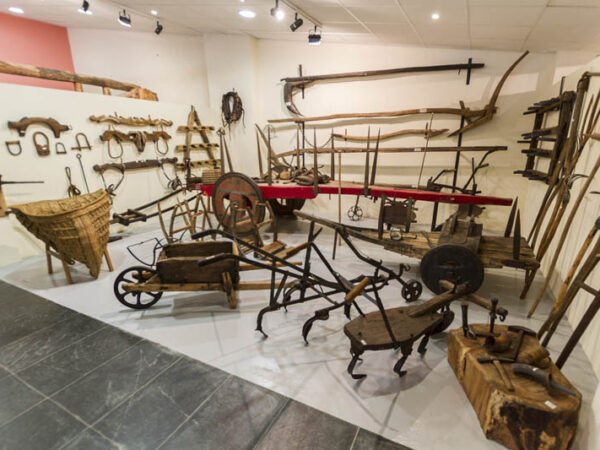After four months of intense work and many setbacks, Salvador Ontiveros Alvarez´s car , (resident of Pacios de Mondelo, Quiroga), is now restored and exhibited at Quiroga´s Municipal Ethnographic Museum. On Monday August 10, 2009 at 1 p.m., coinciding with the most important fair of the year and the eighteenth “Mostra do Mel de Quiroga”, Salvador Ontiveros´ car ran again in Quiroga´s main street way to the Museum. The delivery was in an act in which his family, owner of the vehicle, made a symbolic presentation to Quiroga´s mayor for exhibition in the Ethnographic Museum. Salvador Ontiveros´ family had given the vehicle to the Ethnographic Museum one year ago, but so far not been possible to restore it due to lack of staff to carry out this work. For about three months, two assigned workers (Iván Vazquez Romero and Antonio Díaz de la Fuente), performed maintenance on the Ethnographic Museum, advised by the restorer of Agapito Vila´s Institution. They had to solve many problems to finally restore one of the first Quiroga´s cars. This single-seater vehicle is an unique car that does not belong to any particular business model, since it was built with parts from various sources by Salvador Ontiveros. He was a known neighbor of Pacios de Mondelo who died in 2002 at 103 years old, and that was known for his inventiveness and the many activities he played in his life. Salvador Ontiveros´ family gave, in addition to the vehicle, numerous pieces related to carpentry and a curious machine to make ice cream for exhibition and conservation in Quiroga´s Ethnographic Museum.
Read moreEthnographic Museum
The alpendre
El alpendre was one of the main rooms of the traditional house. In this section we can find the elements related to agriculture and livestock, activities that led to an important part of daily life on these lands in a not-so-distant past. Quiroga’s population had always close links with agriculture and livestock. Both in the parishes of the mountain, as in the valley. The work in the fields and livestock assumed the fundamental basis for the livelihoods of people. Today, the reality is quite different: a declining and aging population striking in rural areas, the progressive concentration of residents in the town of Quiroga and the emergence of new sources of income, among other factors, led to agricultural and livestock activities to reduce its importance or disappeared altogether. Today, the only crop that remains relevant and charges annually increasing is the wine. As it couldn’t be otherwise, old farming tools were replaced by the latest technologies, and wooden plows, harrows, yokes, ox carts, and litter, etc, were forgotten. In this room called “O Pendello” essential at any home, have been recovered much of the elements that were once prominent part of everyday life for most of the neighbors.
Read moreThe iron
Iron tradition was always magnificent in Courel Mountains; Fifteen forges supplied material to numerous existing smithies in the villages to obtain all kinds of tools and pieces of this precious material. La tradición del hierro siempre fue grande en Quiroga con numerosas herrerías emplazadas en su territorio, aprovechando los numerosos cursos de aguas bravas que bajan desde las cimas de las montañas.Hoy sólo quedan restos dispersos de su existencia, pero desde el siglo XVII funcionaron en tierras de Quiroga las factorías de: O O Mazo, Roxa Longa entre Vilarbacú y Outeiro, Paleiras en Pacios da Serra, A Gorgueira en Paradaseca, Rugando, Quintá y A Rodela.La mayor parte del mineral que utilizaban las herrerías provenía del filón del monte Formigueiros. Teniendo en cuenta la gran cantidad de hierro transformado en estas protoindustrias metalúrgicas, resulta fácil explicar que en cada aldea existiera por lo menos una fragua, en la que se obtenían todo tipo de elementos fabricados, con gran habilidad por los herreros, con este metal.La sala dedicada a Agapito Vila Rodríguez, reproduce fielmente una fragua tradicional, en la que puede verse desde el abrquín que alimenta el fuego, hasta una impresionante broca para hierro, además de una completísima colección de útiles procedentes de los herreros de las distintas parroquias del ayuntamiento de Quiroga.
Read moreOther rooms
Tasting Room Space dedicated to wine tasting and other typical products. On the walls of this room you can see: Gallery of Mayors (virtual review about Quiroga’s mayors since 1890). AUDIO-VISUAL ROOM Media space, for 15 people, dedicated to show various aspects of the functioning of the machines that occupy the museum halls. Travel through images to manufacturing processes of handcraft products made in Quiroga; know the environment in which these activities take place or come to the Historical, Artistic and cultural life of this land of contrasts. EDUCATIONAL PANELS There are many unique elements of Quiroga´s environment which by their nature can´t be exhibited in the museum rooms. These elements are represented in modern and didactic information panels that allow a more complete visit at their place of location.
Read more



